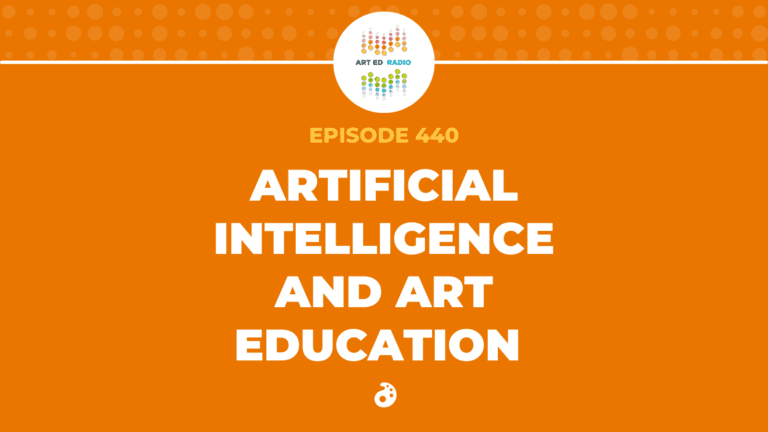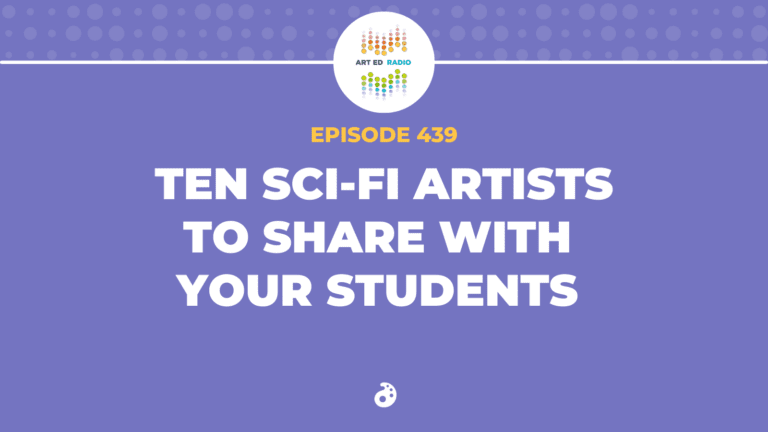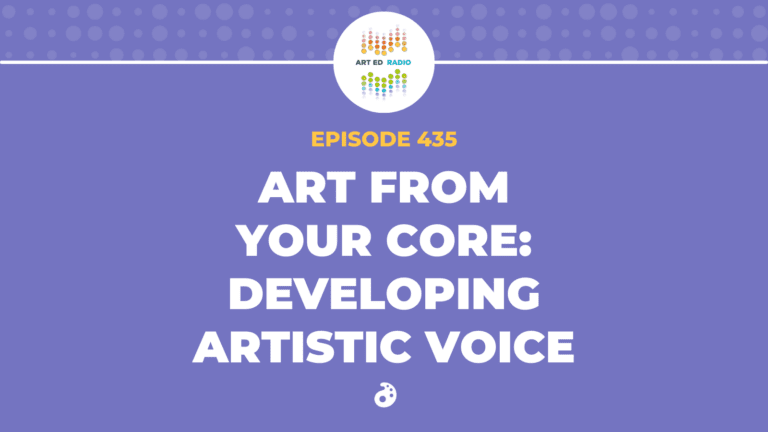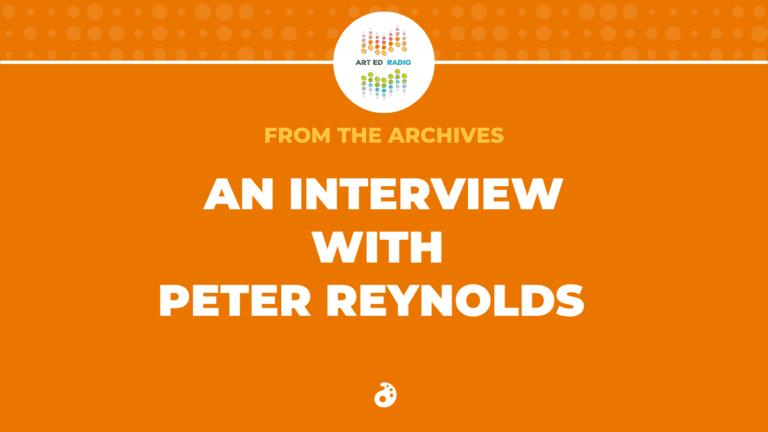Engagement
Offering Choice and Teaching About Careers Through Distance Learning (Ep. 136)
April 9, 2020
Over the past few weeks, Nic has been refining her teaching and figuring out what will work the best for her students with distance learning. In today’s episode, she shares some of her best plans, lessons, and strategies, including why she is taking this opportunity to help her students focus on careers in the arts. Full Episode Transcript Below.
Resources and Links
- View all of AOEU’s resources to help with distance learning
- Nic’s YouTube page is here
- Nic’s Architecture Post
- 60 Visual Arts Careers to Discuss with Your Students
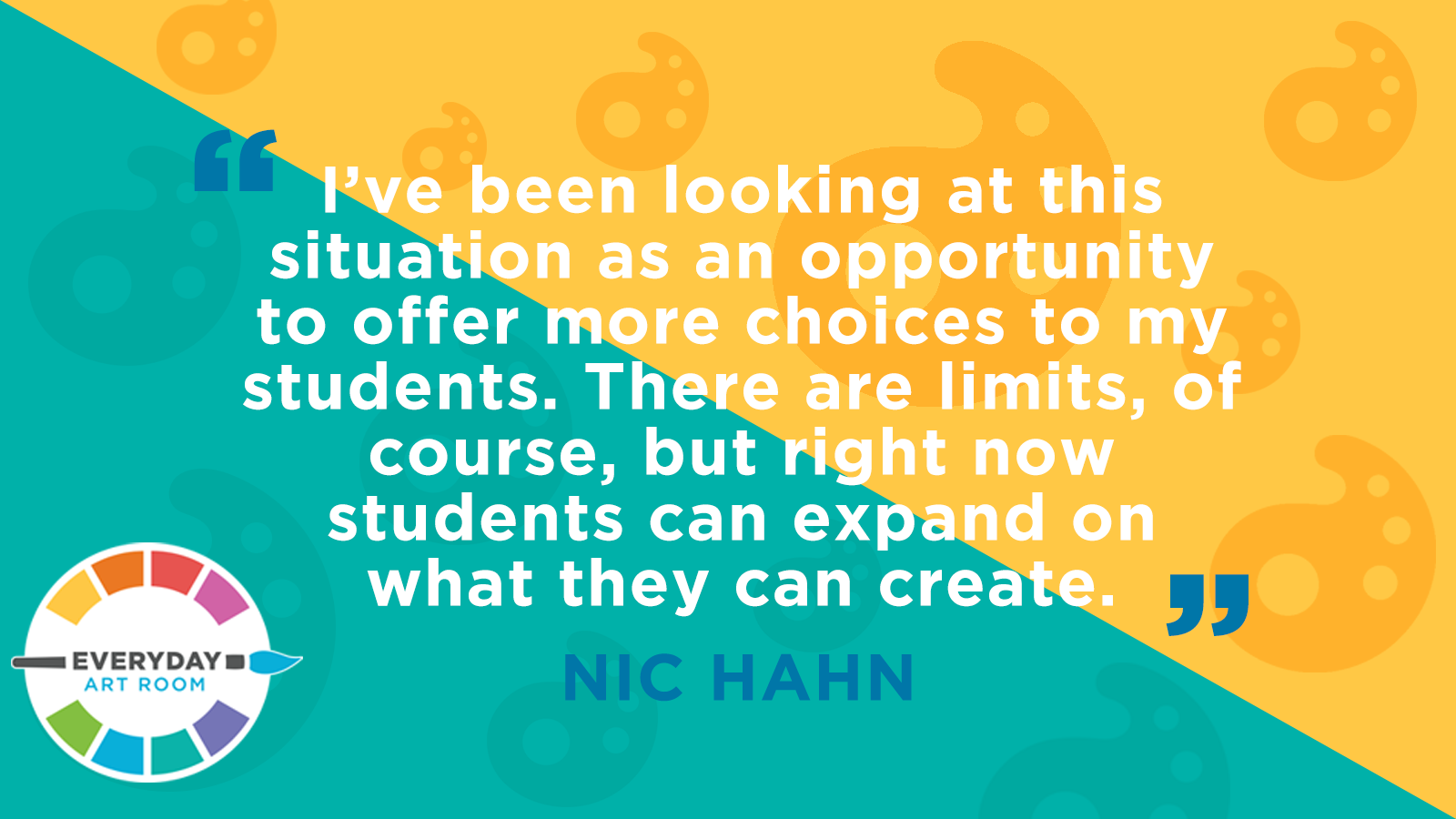
Transcript
Nic: Okay, here we are. Week number something for all of us teaching distance learning, right? And as we are developing our curriculum for online or digital learning or distance learning, whatever you’re calling it at your place, we are thinking about what is sustainable. So I’m thinking back to a previous podcast that I had with Kit Lang and Zoe Coughlan and they mentioned making sure whatever you choose to do during this time it’s sustainable because this is that undetermined time how long you will be teaching in this way. We don’t know if it’s going to be the next month or months. So let’s make it sustainable. And this is how I ended up going about my curriculum after that nugget of advice. This is Nic Hahn and this is Everyday Art Room.
All of us were tasked most recently to come up with ways that we’re going to teach our students at home. And wow, only educators could be told you have one day, two days, even two weeks to work on something that’s completely different than you ever have, make sure that it’s quality and that you can assess it and that it’s accessible to all but not too much and make it happen right now. And of course educators are like, “Yep. Okay. Got it. Go.” Right? We are amazing, we are adaptable and we can make this happen. In fact, most recently one of the big changes that just happened was that NAEA was supposed to be in Minneapolis, the Convention For The National Art Educators and it was supposed to be in Minneapolis and it was canceled. And so what happened was Cindy Ingram, who is the owner of Art Class Curator, her and her team reached out to educators that were supposed to present and she decided to put together very quickly an entire week of professional development that she called an unconference.
I was honored to be one of the presenters for her unconference and I presented on how I’m creating choice-based learning at home during this distance learning time. That’s what we’re going to talk about today is kind of the path I’ve taken and if it works for you, please use it. Maybe just parts of it will. So that’s what we’re going to talk about. For my class in the past, during third grade, a couple of years ago I started experimenting with choice-based. I just haven’t totally gone what some people call TAB, teaching with artistic behaviors. I haven’t gone full choice, but I do like giving my students as much choice as possible as they’re learning in my four walls. And I’ve decided that it works when my numbers are appropriate, which means I can have the people in my classroom moving around and I have space for it, when I have money in my budget to make sure that I have all of the different stations of high quality.
And for me, those are two things that have kind of gotten in the way this last year. So choice-based has kind of gone to the side for me, until now, until distance learning. Now I’m taking a look at my curriculum and I’m saying, “Hey, you know what? In a way, my class size is much smaller right now. It’s only the people in a home that are involved in this class.” And no, I don’t have a budget to give them all the materials that they need, but I know what they have at home, for the most part, with most of my students so maybe I can give them a little bit of choice. And if choice is no more than if you have these supplies only, this is what you can go ahead and make, but if you have this or this or this, go ahead and expand what you can create.
So, yes, I’m moving forward with choice-based and again I’m thinking about those messages I got from Kitt Lang and Zoe Kauflin in a previous podcast interview when they were talking to us about the lessons that they’ve learned teaching in Hong Kong and being a little ahead of us as far as distance learning. And one of the things that kept resinating in my brain was stay sustainable, something that you can continue to do week after week after week. That led me to choosing careers in art as my overarching idea for all of my distance learning. I am super excited about this. Every single week I’m going to give a theme that falls under that category of careers in art. And kindergarten through fifth grade has the same exact theme as well as the same choice board to create from. So let me back up.
I have decided to present my learning on Google Slides and I use Google Slides in my class on a pretty regular basis. So my first slide just introduces myself and all the different ways to get ahold of me as well as my office hours. I think that’s really important to put on there to make sure that parents and students know that I’m working scheduled office hours for the most part. Then I go into a second page and this second page gives them links to the three steps that they have to do. They have to learn about the theme of the week, they have to create something under that theme, and they have to upload a picture, and there’s different ways of doing that. We’ll get into that later. Then I do have an option four, which are different contests and challenges that they can participate in. So this is allowing my gifted and talented students or my more engaged in the visual arts students to seek those extras very readily at the tip of their fingers.
My first theme that I decided to go with for my whole entire school on week one of distance learning was architecture. So the first thing that I did was ask them to watch a video that I embedded into this Google slide of me explaining what architecture is. And I also give a brief description of the four options that they have to choose from on the choice board. I ended up putting in a couple of other videos because I found this kind of rock hip hop song on a YouTube about architecture if there were such a thing. It’s real cheesy and I love it. And then Iggy Peck Architect I think is the name of the book. So we have those two videos on there as well to just kind of give a little extra for students to watch when they’re learning about architecture.
Then the following page it says, “The theme is architecture and here is the choice board.” Each of these choices have a link to kind of a how to or inspirational video to kind of prompt them in some way. All of these choices actually were choices that I have provided within my classroom so I knew the joy that it brought to students as they participated in this already. I’m just asking them to do it at their homes now. And again, remember, this is kindergarten through fifth grade, all with the same theme and the same choice board so if they want to work collaboratively, I encourage that. I allow them to. I want them to be working as a team as I did in my class as well.
So the first option is just to draw a building and I give some examples of some drawings of buildings, but I keep it very, very simple. If a student only has paper and a pen, they can draw a building. Even if they have, I don’t know, a garbage sack or a paper bag that they can draw on it. They have what they need to draw a building. And then I should also mention that my district, I can guarantee that all of my students have a device so they are able to take that picture because my district was able to provide that for every single person. They all have internet and they all have devices. So if you’re wondering about that and how I’m able to ask them to do these two things and view this, that is the situation that I’m in. So I’m very lucky in that way.
The second choice that they got to do was build with blocks or Legos and I actually provide a link to the YouTube channel of Lego Masters. If the students have not heard of Lego Masters, they might have a little bit of time to watch TV right now and Lego Masters is a really, really good show to sit down and watch as a family. And I know that it’s streaming right now and I know that’s live on Wednesdays as well. So I wanted to encourage students to maybe watch that if they needed inspiration. And then found object structures, so using paper towel tubes and cardboard and paper and pencils and paint to create a structure, and well I’ll get into what I’m seeing in just a moment. But that that was another option. And then the final option was build a fort with blankets.
So in my classroom, I brought it in all of the old sheets that we had since we were married and that was 100 years ago. So they were ready to leave our house and I brought them to school. Of course, I don’t throw anything away, right? And I asked my students to create a fort together. That was one of the choices they had in the classroom as well, and they had such a blast using the chairs and the tables, moving things around, getting the blankets just so, so that they balanced and they didn’t fall on people and getting the whole class underneath the fort. It was so much fun that I knew that this would be a good option for our students to choose from. Now, that was another tip that we received from Hong Kong, was make sure that these students have opportunities to create and get off line as much as possible. So that was another driving force that I had in the back of my mind when I came up with choices for my students to do.
Before I talk about uploading, I want to talk about some of the … Well, no, I’ll talk about uploading first because I have three different ways that students upload in my classroom. Every single time that we’re done with a project in kindergarten through second grade, I have been teaching my students the entire school year to take a picture of their art and I try to teach them to take a quality picture, crop it, make sure it’s right side up, but that’s developing and it does kindergarten through second grade. They take a picture of their art and then they upload it to Seesaw. So that is an app that my school uses for communication, home mostly, but also for assessment and education. And in this case, we’re actually using it to teach our kindergarten through second graders as well. But they can upload an image onto Seesaw because we’ve been practicing that so much.
It was a little bit harder with my third through fifth grade because all I’ve been asking them and training them to do at the end of their projects is take a picture and put it into a Google folder. I do not see it because I see the actual work in my classroom. They are keeping this archive, this digital portfolio, in Google Drive so that at the end of the year we can go and make a Google Slide and they can tell me what they really enjoyed doing throughout the school year. So it’s kind of an archive of what we’ve accomplished this year. That was my intent at the beginning of the school year, but things have taken a rapid turn. So I’m still asking them to take a picture and put it into their Google Drive but I’m noticing that we’re having a little bit of a hard time doing that because they want to show me what they’re making.
So right now we’re kind of working through that situation. I think I have a plan. I’m going to keep researching. I’m going to keep watching. We use Schoology or Schoolology, whichever way you say it. We use Schoology in third grade through 12th grade, but our third, fourth and fifth grade just aren’t trained well yet for submitting artwork onto Schoology. So I’m working through that and I think we’re going to have probably another podcast of how to celebrate the art that is being made in the near future. So put that part on hold, but right now kindergarten through second grade, putting it on Seesaw. Two through fifth, they are taking a picture of it and just dropping it into their Google Drive folder. But like I said, so many kids are wanting to show me what they’re creating so I’m getting emails on a very regular basis, which I love. It’s great. They’re just sending me pictures, telling me, “Look, Miss Hahn. Look what I’ve done.”
And Seesaw has been amazing because I’m not only seeing the pictures, but we’ve practiced recording the process as well so I hear their little voices saying, “My dad and I made this fort today and it was really fun to make it, but the most fun was when my dad came in and started playing in the fort with me.” Oh, you guys. I mean, it just makes my heart soar to think that because of the encouragement and the choice board that I have given my students, I have parents playing with their children. I have entire living rooms that have been turned into a fort. I have students that have gone through the junk in their house to find just the right materials to create some amazing architecture, and I’m telling you, it is truly amazing what they’re sending back to me.
Every single week they’re going to have a new theme. So I’ve just described one theme, the things that are going to be the same. I’m going to have a video explaining the theme. I’m going to have a choice board. Four different choices ranging from materials of low technology all the way up to, maybe I’ll add some technology. Actually, that’s been a hard thing because I do like digital art and I like offering that, but I am really holding back assigning any kind of digital right now. I’m trying to make it more physical. So I’ll give some options of some different materials in case kids have other materials such as paints and sculpture materials at home because I know that some of my students do indeed have those.
But what I loved about this last lesson is even though I’m asking them to create, and I gave them four ideas, I did have a lot of students going outside, picking up sticks and making forts that way. Now, technically that is a found object, but I didn’t tell them, “Hey, go outside and do this.” I had students that submitted architecture with drawing on their whole entire driveway. They used chalk and they drew this. And I knew this was going to happen, guys. When you give your students choice, when you say, “Do what’s out of your brain. Make it big. Make it bold. Make it awesome,” they do. They will impress you. There are going to be students that will absolutely blow you away with what they create and that is what I’m finding with my careers in art choice-based distance learning that’s happening right now.
As I wrap up this podcast all about careers in arts and choice-based learning, one thing that I’ve been asked as I’ve presented this in different ways at the recent webinar which I encourage you to go to those webinars on Thursday nights, go to the Art of Education University webpage, the homepage. The very first page you’re going to see right now is all about COVID-19, just really a kit for you guys. It has a bunch of resources, but then there is a webinar every Thursday night that is being run with great, great content and I was invited to speak last week on week three. So go ahead and check that one out. I talk about how to record in a very short and concise way if you’re making flip videos. But beyond that I’m going to add a link in the podcast here about an article that truly inspired me when it came to careers in art.
I found out going through my YouTube channel that I have a ton of resources as far as videos of different careers in art and different directions that I’ve gone in the past. But I didn’t have enough for what I anticipate I will need for the rest of distance learning. So I started seeking, as I always do. I Googled careers in art for kids, where can I find that? Guess what popped up? The Art of Education University’s webpage was number one, and on there, I forgot about this, I knew about it, but they have an amazing 60 visual art careers download. It has everything from advertising to fashion design to photographer and film. And then it breaks it down even further. So when it talks about fashion, it has fashion designer, jewelry, designer makeup artists, and stylists. So even under those big umbrellas of careers in art, there are little sub umbrellas that you could task your kids to do when giving them careers in art choice-based learning. So definitely check that out. Check out my YouTube page for some resources as well. And do not miss those webinars every Thursday night.
Magazine articles and podcasts are opinions of professional education contributors and do not necessarily represent the position of the Art of Education University (AOEU) or its academic offerings. Contributors use terms in the way they are most often talked about in the scope of their educational experiences.
